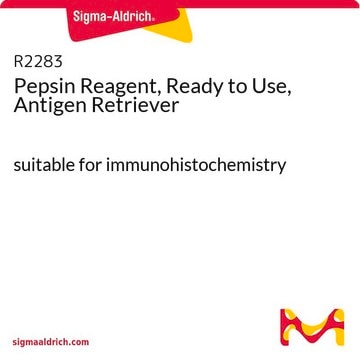This falls under the research grade.
Kluczowe dokumenty
P7125
Pepsin from porcine gastric mucosa
powder, ≥400 units/mg protein
Synonim(y):
Pepsin A, Pepsin from hog stomach
Wybierz wielkość
548,00 zł
Wybierz wielkość
About This Item
548,00 zł
Polecane produkty
pochodzenie biologiczne
Porcine gastric mucosa
Poziom jakości
Formularz
powder
aktywność właściwa
≥400 units/mg protein
masa cząsteczkowa
35 kDa
rozpuszczalność
10 mM HCl: soluble 1.0 mg/mL, clear to faintly turbid, colorless
numer dostępu UniProt
temp. przechowywania
2-8°C
informacje o genach
pig ... LOC396892(396892)
Szukasz podobnych produktów? Odwiedź Przewodnik dotyczący porównywania produktów
Powiązane kategorie
Zastosowanie
Działania biochem./fizjol.
Pepsin is the major proteolytic enzyme produced in the stomach. It digests proteins through the cleavage of interior peptide linkages.[8]
Definicja jednostki
Komentarz do analizy
Inne uwagi
Inhibitor
Hasło ostrzegawcze
Danger
Zwroty wskazujące rodzaj zagrożenia
Zwroty wskazujące środki ostrożności
Klasyfikacja zagrożeń
Eye Irrit. 2 - Resp. Sens. 1 - Skin Irrit. 2 - STOT SE 3
Organy docelowe
Respiratory system
Kod klasy składowania
11 - Combustible Solids
Klasa zagrożenia wodnego (WGK)
WGK 1
Temperatura zapłonu (°F)
Not applicable
Temperatura zapłonu (°C)
Not applicable
Środki ochrony indywidualnej
dust mask type N95 (US), Eyeshields, Faceshields, Gloves
Wybierz jedną z najnowszych wersji:
Certyfikaty analizy (CoA)
Nie widzisz odpowiedniej wersji?
Jeśli potrzebujesz konkretnej wersji, możesz wyszukać konkretny certyfikat według numeru partii lub serii.
Masz już ten produkt?
Dokumenty związane z niedawno zakupionymi produktami zostały zamieszczone w Bibliotece dokumentów.
Klienci oglądali również te produkty
Protokoły
This procedure may be used for determination of Pepsin activity using hemoglobin as the substrate. It is a spectrophotometric stop rate determination.
-
Can you please tell me the Grade of this product?
1 answer-
Helpful?
-
-
Hi, What is the shelf life for this product? Thanks
1 answer-
This product is not assigned an expiration date or recommended retest date. Products with no expiration date or recommended retest date should be routinely inspected by customers to ensure they perform as expected. These products are also subject to a one year warranty from the date of shipment. For more information you may access the "Product Dating Information" document under "ADDITIONAL USEFUL DOCUMENTS ABOUT OUR PRODUCTS" at the bottom of the Quality Services page with this link: https://www.sigmaaldrich.com/life-science/quality-and-regulatory-management/quality-services.
Helpful?
-
-
Which Pepsin do you recommend for histology/antigen retrevial? According to protocol 0.2mg/ml in 0.2M HCL
1 answer-
This product has not been specifically qualified for antigen retrieval, however, it may be able to be qualified for use by the end user. A typical protocol using pepsin for antigen retrieval suggests the following stock and working solutions:
Pepsin Stock Solution (1% in 10mM HCl):
Pepsin ------------------------------------- 100 mg
10mM HCl (pH 2.0) ---------------------- 10 mlMix to dissolve. Store at -20 ºC
Pepsin Working Solution (0.5% in 5mM HCl):
Pepsin Stock Solution (0.5%) ------------ 1 ml
Distilled water ---------------------------- 1 mlMix well.
For antigen retrieval - cover sections with pepsin working solution and incubate for 10-20 minutes at 37 °C in humidified chamber (optimal incubation time may vary depending on tissue type and degree of fixation, and should be determined by user).
Product R2283 is a pepsin product qualified for antigen retrieval https://www.sigmaaldrich.com/product/sigma/r2283.
For more information, please see the following link: https://www.sigmaaldrich.com/technical-documents/protocol/protein-biology/immunohistochemistry/immunohistochemistry-protocol#antigen_retrieval.
Helpful?
-
Active Filters
Nasz zespół naukowców ma doświadczenie we wszystkich obszarach badań, w tym w naukach przyrodniczych, materiałoznawstwie, syntezie chemicznej, chromatografii, analityce i wielu innych dziedzinach.
Skontaktuj się z zespołem ds. pomocy technicznej












